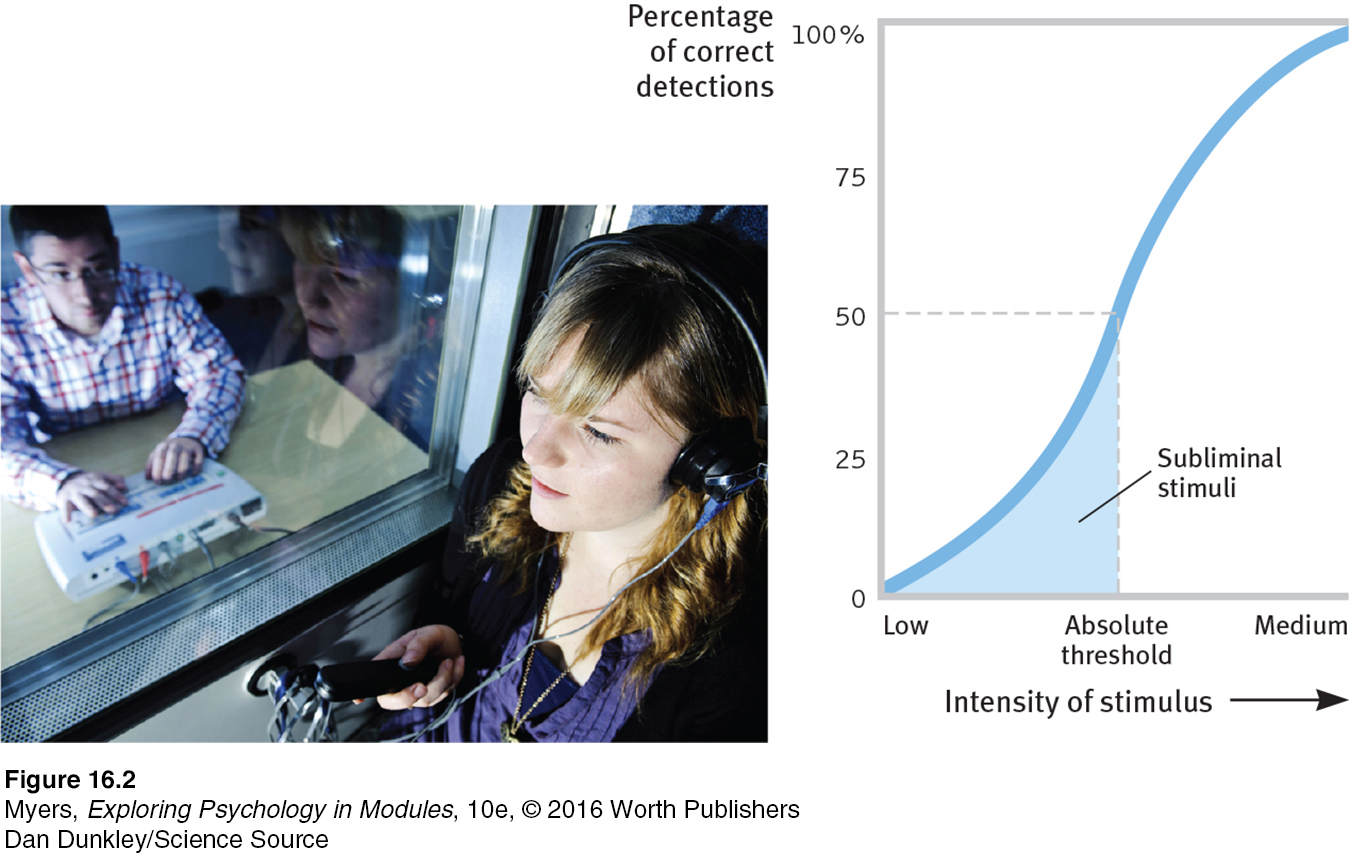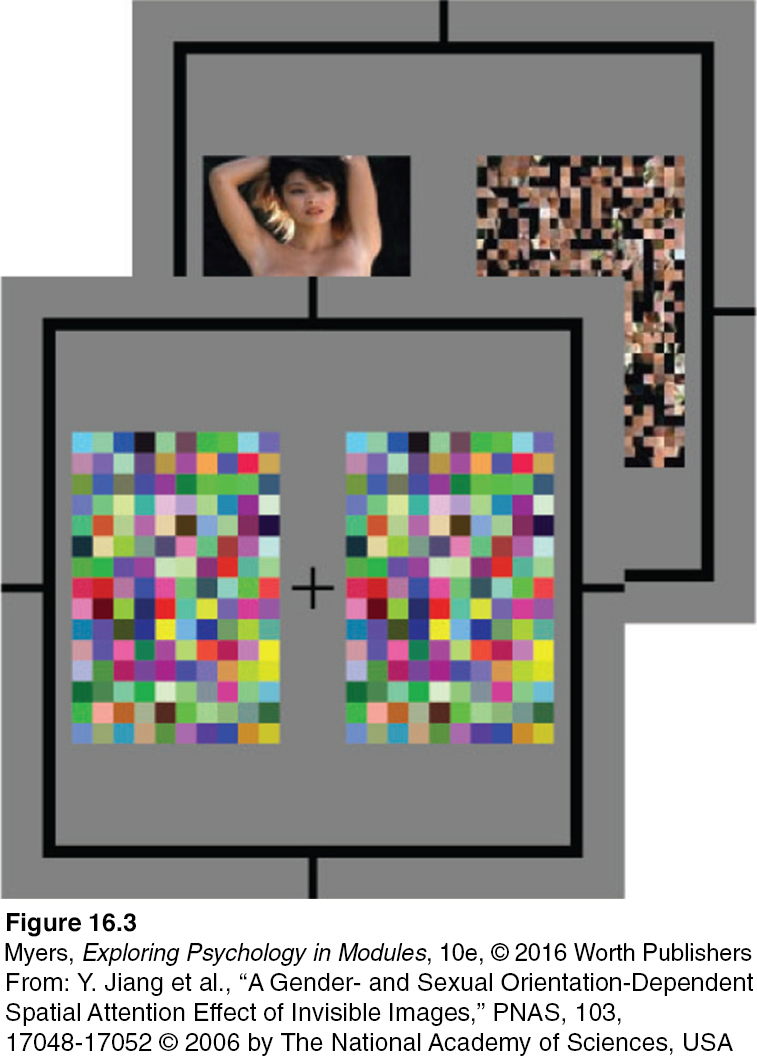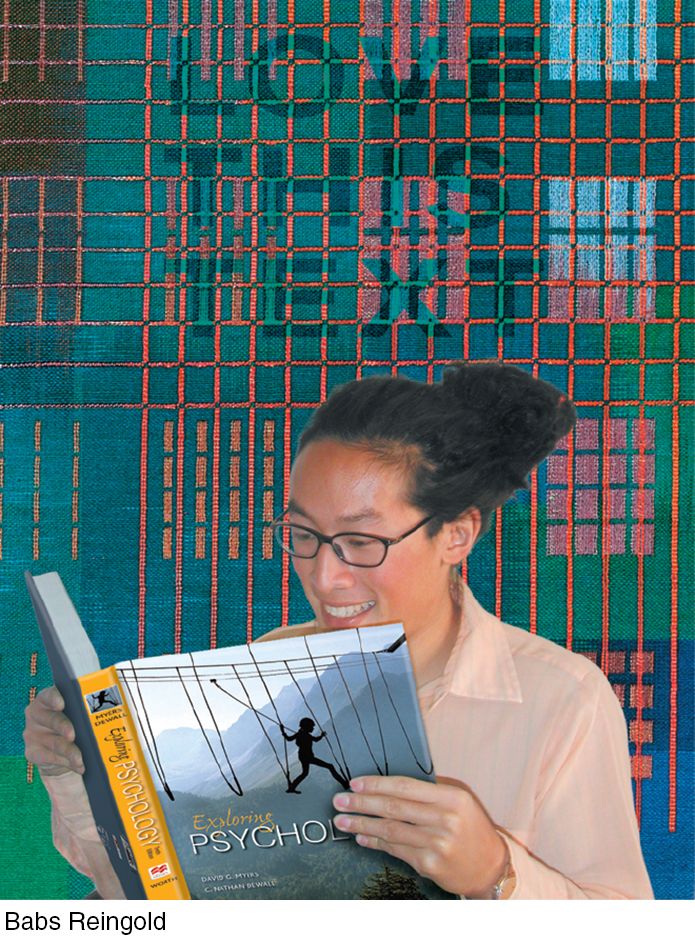16.3 Thresholds
16-
At this moment, we are being struck by X-
The shades on our own senses are open just a crack, allowing us a restricted awareness of this vast sea of energy. But for our needs, this is enough.
Absolute Thresholds
To some kinds of stimuli we are exquisitely sensitive. Standing atop a mountain on an utterly dark, clear night, most of us could see a candle flame atop another mountain 30 miles away. We could smell a single drop of perfume in a three-
absolute threshold the minimum stimulus energy needed to detect a particular stimulus 50 percent of the time.
German scientist and philosopher Gustav Fechner (1801–

signal detection theory a theory predicting how and when we detect the presence of a faint stimulus (signal) amid background stimulation (noise). Assumes there is no single absolute threshold and that detection depends partly on a person’s experience, expectations, motivation, and alertness.
Detecting a weak stimulus, or signal (such as a hearing-
subliminal below one’s absolute threshold for conscious awareness.
priming the activation, often unconsciously, of certain associations, thus predisposing one’s perception, memory, or response.
 See LaunchPad's Video: Experiments, below, for a helpful tutorial animation about this type of research method.
See LaunchPad's Video: Experiments, below, for a helpful tutorial animation about this type of research method.
Stimuli you cannot consciously detect 50 percent of the time are subliminal—below your absolute threshold (see FIGURE 16.2). Under certain conditions, you can still be affected by stimuli so weak that you don’t consciously notice them. An unnoticed image or word can reach your visual cortex and briefly prime your response to a later question. In a typical experiment, the image or word is quickly flashed, then replaced by a masking stimulus that interrupts the brain’s processing before conscious perception (Herring et al., 2013; Van den Bussche et al., 2009). In one such experiment, researchers monitored brain activity as they primed people with either unperceived action words (such as go and start) or inaction words (such as still and stop). Without any conscious awareness, the inaction words automatically evoked brain activity associated with inhibiting behavior (Hepler & Albarracin, 2013).
Another priming experiment illustrated the deep reality of sexual orientation. As people gazed at the center of a screen, a photo of a nude person was flashed on one side and a scrambled version of the photo on the other side (Jiang et al., 2006). Because the nude images were immediately masked by a colored checkerboard, viewers consciously perceived nothing but flashes of color and so were unable to state on which side the nude had appeared. To test whether this unseen image had unconsciously attracted their attention, the experimenters then flashed a geometric figure to one side or the other. This, too, was quickly followed by a masking stimulus. When asked to give the figure’s angle, straight men guessed more accurately when it appeared where a nude woman had been a moment earlier (FIGURE 16.3). Gay men (and straight women) guessed more accurately when the geometric figure replaced a nude man. As other experiments confirm, we can evaluate a stimulus even when we are not consciously aware of it—

“The heart has its reasons which reason does not know.”
Pascal, Pensées, 1670
How can we feel or respond to what we do not know and cannot describe? An imperceptibly brief stimulus often triggers a weak response that can be detected by brain scanning (Blankenburg et al., 2003; Haynes & Rees, 2005, 2006). The stimulus may reach consciousness only when it triggers synchronized activity in multiple brain areas (Dehaene, 2009, 2014). Such experiments reveal the dual-
So can we be controlled by subliminal messages? For more on that question, see Thinking Critically About: Subliminal Persuasion.
Difference Thresholds
To function effectively, we need absolute thresholds low enough to allow us to detect important sights, sounds, textures, tastes, and smells. We also need to detect small differences among stimuli. A musician must detect minute discrepancies when tuning an instrument. Parents must detect the sound of their own child’s voice amid other children’s voices. I [DM] noticed while living two years in Scotland that sheep baas all sound alike to my ears. But not to those of ewes, who, after shearing, will streak directly to the baa of their lamb amid the chorus of other distressed lambs.

difference threshold the minimum difference between two stimuli required for detection 50 percent of the time. We experience the difference threshold as a just noticeable difference (or jnd).
Weber’s law the principle that, to be perceived as different, two stimuli must differ by a constant minimum percentage (rather than a constant amount).
The difference threshold (or the just noticeable difference [jnd]) is the minimum difference a person can detect between any two stimuli half the time. That difference threshold increases with the size of the stimulus. If we listen to our music at 40 decibels, we might detect an added 5 decibels. But if we increase the volume to 110 decibels, we probably won’t detect a 5-

THINKING CRITICALLY ABOUT
Subliminal Persuasion
16-
Hoping to penetrate our unconscious, entrepreneurs offer audio and video programs to help us lose weight, stop smoking, or improve our memories. Soothing ocean sounds may mask messages we cannot consciously hear: “I am thin”; “Smoke tastes bad”; or “I do well on tests—
As we have seen, subliminal sensation is a fact. Remember that an “absolute” threshold is merely the point at which we can consciously detect a stimulus half the time. At or slightly below this threshold, we will still consciously detect the stimulus some of the time.
But does this mean that claims of subliminal persuasion are also facts? The near-

To test whether subliminal recordings have this enduring effect, Anthony Greenwald and his colleagues (1991, 1992) randomly assigned university students to listen daily for five weeks to commercial subliminal messages claiming to improve either self-
Were the recordings effective? Students’ test scores for self-
Over a decade, Greenwald conducted 16 double-
RETRIEVE IT
Question
Using sound as your example, explain how these concepts differ: absolute threshold, subliminal stimulation, and difference threshold.